ASRock G41M-GS User Manual

Copyright Notice:
No part of this installation guide may be reproduced, transcribed, transmitted, or translated in any language, in any form or by any means, except duplication of documentation by the purchaser for backup purpose, without written consent of ASRock Inc.
Products and corporate names appearing in this guide may or may not be registered trademarks or copyrights of their respective companies, and are used only for identification or explanation and to the owners’ benefit, without intent to infringe.
Disclaimer:
Specifications and information contained in this guide are furnished for informational use only and subject to change without notice, and should not be constructed as a commitment by ASRock. ASRock assumes no responsibility for any errors or omissions that may appear in this guide.
With respect to the contents of this guide, ASRock does not provide warranty of any kind, either expressed or implied, including but not limited to the implied warranties or conditions of merchantability or fitness for a particular purpose. In no event shall ASRock, its directors, officers, employees, or agents be liable for any indirect, special, incidental, or consequential damages (including damages for loss of profits, loss of business, loss of data, interruption of business and the like), even if ASRock has been advised of the possibility of such damages arising from any defect or error in the guide or product.
This device complies with Part 15 of the FCC Rules. Operation is subject to the following two conditions:
(1)this device may not cause harmful interference, and
(2)this device must accept any interference received, including interference that may cause undesired operation.
CALIFORNIA, USA ONLY
The Lithium battery adopted on this motherboard contains Perchlorate, a toxic substance controlled in Perchlorate Best Management Practices (BMP) regulations passed by the California Legislature. When you discard the Lithium battery in California, USA, please follow the related regulations in advance.
“Perchlorate Material-special handling may apply, see www.dtsc.ca.gov/hazardouswaste/perchlorate”
ASRock Website: http://www.asrock.com
Published July 2009
Copyright©2009 ASRock INC. All rights reserved.
1
English
ASRock G41M-GS Motherboard
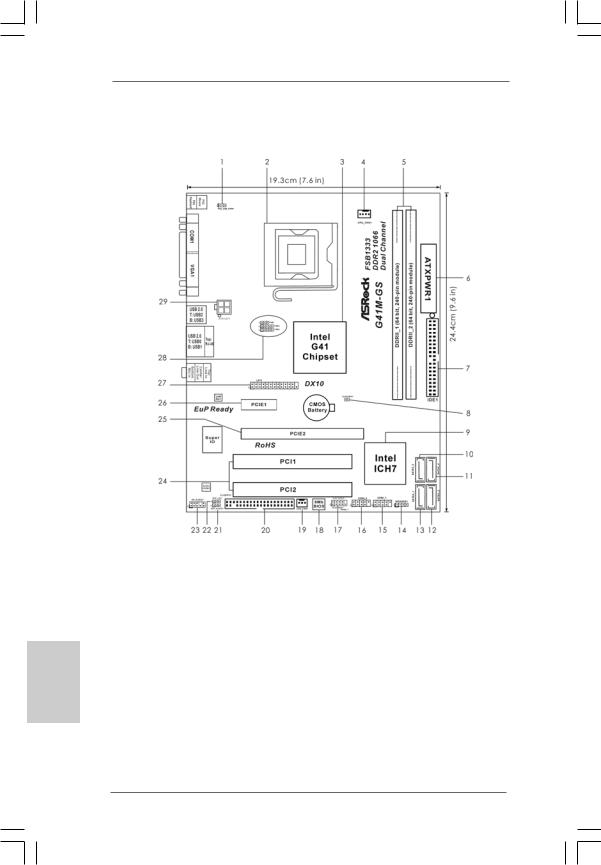
Motherboard Layout
English
1 |
PS2_USB_PWR1 Jumper |
16 |
USB 2.0 Header (USB4_5, Blue) |
2 |
775-Pin CPU Socket |
17 |
System Panel Header (PANEL1, Orange) |
3 |
North Bridge Controller |
18 |
BIOS SPI Chip |
4 |
CPU Fan Connector (CPU_FAN1) |
19 |
Chassis Fan Connector (CHA_FAN1) |
5 |
2 x 240-pin DDR2 DIMM Slots |
20 |
Floppy Connector (FLOPPY1) |
|
(Dual Channel: DDRII_1, DDRII_2; Yellow) |
21 |
EUP Audio Jumper (EUP_AUDIO1) |
6 |
ATX Power Connector (ATXPWR1) |
22 |
EUP LAN Jumper (EUP_LAN1) |
7 |
IDE1 Connector (IDE1, Blue) |
23 |
Front Panel Audio Header |
8 |
Clear CMOS Jumper (CLRCMOS1) |
|
(HD_AUDIO1, Lime) |
9 |
South Bridge Controller |
24 |
PCI Slots (PCI1- 2) |
10 |
Third SATAII Connector (SATAII_3; Orange) |
25 |
PCI Express x16 Slot (PCIE2) |
11 |
Fourth SATAII Connector (SATAII_4; Orange) |
26 |
PCI Express x1 Slot (PCIE1) |
12 |
Secondary SATAII Connector (SATAII_2; Red) |
27 |
Print Port Header (LPT1, Purple) |
13 |
Primary SATAII Connector (SATAII_1; Red) |
28 |
FSB1 / FSB2 / FSB3 Jumper |
14 |
Chassis Speaker Header (SPEAKER 1, Purple) |
29 |
ATX 12V Connector (ATX12V1) |
15 |
USB 2.0 Header (USB6_7, Blue) |
|
|
2
ASRock G41M-GS Motherboard
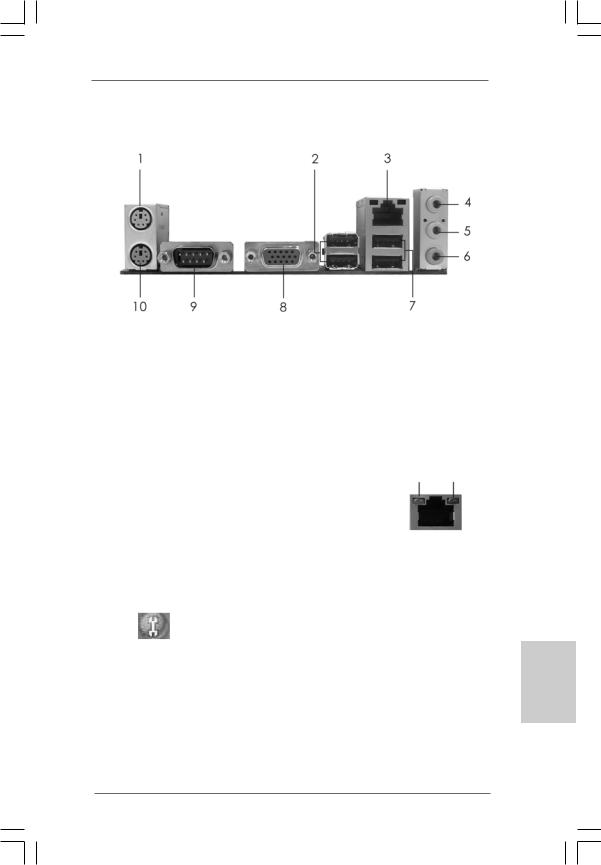
I/O Panel
1 |
PS/2 Mouse Port (Green) |
6 |
Microphone (Pink) |
|
2 |
USB 2.0 Ports (USB23) |
7 |
USB 2.0 Ports (USB01) |
|
* 3 |
RJ-45 Port |
8 |
VGA Port |
|
4 |
Line |
In (Light Blue) |
9 |
COM Port |
5 |
Line |
Out (Lime) |
10 |
PS/2 Keyboard Port (Purple) |
*There are two LED next to the LAN port. Please refer to the table below for the LAN port LED indications.
LAN Port LED Indications
Activity/Link LED |
|
SPEED LED |
ACT/LINK |
SPEED |
|||
|
LED |
LED |
|||||
Status |
Description |
|
Status |
|
Description |
||
|
|
|
|
||||
Off |
No Link |
|
Off |
|
10Mbps connection |
|
|
Blinking |
Data Activity |
|
Orange |
|
100Mbps connection |
|
|
On |
Link |
|
Green |
|
1Gbps connection |
LAN Port |
|
|
|
|
|
|
|
||
*To enable Multi-Streaming function, you need to connect a front panel audio cable to the front panel audio header. Please refer to below steps for the software setting of Multi-Streaming.
For Windows® XP:
After restarting your computer, you will find “Mixer” tool on your system. Please select “Mixer
ToolBox” |
, click “Enable playback multi-streaming”, and click “ok”. Choose “2CH” or |
“4CH” and then you are allowed to select “Realtek HDA Primary output” to use Rear Speaker and Front Speaker, or select “Realtek HDA Audio 2nd output” to use front panel audio. Then reboot your system.
For Windows® VistaTM:
After restarting your computer, please double-click “Realtek HD Audio Manager” on the system tray. Set “Speaker Configuration” to “Quadraphonic” or “Stereo”. Click “Device advanced settings”, choose “Make front and rear output devices playbacks two different audio streams simultaneously”, and click “ok”. Then reboot your system.
3
English
ASRock G41M-GS Motherboard

1. Introduction
Thank you for purchasing ASRock G41M-GS motherboard, a reliable motherboard produced under ASRock’s consistently stringent quality control. It delivers excellent performance with robust design conforming to ASRock’s commitment to quality and endurance.
This Quick Installation Guide contains introduction of the motherboard and step-by-step installation guide. More detailed information of the motherboard can be found in the user manual presented in the Support CD.
Because the motherboard specifications and the BIOS software might be updated, the content of this manual will be subject to change without notice. In case any modifications of this manual occur, the updated version will be available on ASRock website without further notice. You may find the latest VGA cards and CPU support lists on ASRock website as well. ASRock website http://www.asrock.com
If you require technical support related to this motherboard, please visit our website for specific information about the model you are using. www.asrock.com/support/index.asp
1.1 Package Contents
ASRock G41M-GS Motherboard
(Micro ATX Form Factor: 9.6-in x 7.6-in, 24.4 cm x 19.3 cm) ASRock G41M-GS Quick Installation Guide
ASRock G41M-GS Support CD
One 80-conductor Ultra ATA 66/100 IDE Ribbon Cable (Optional) One Serial ATA (SATA) Data Cable (Optional)
One I/O Panel Shield
hsilgnE
4
ASRock G41M-GS Motherboard

1.2Specifications
Platform |
- Micro ATX Form Factor: 9.6-in x 7.6-in, 24.4 cm x 19.3 cm |
CPU |
- LGA 775 for Intel® CoreTM 2 Extreme / CoreTM 2 Quad / CoreTM |
|
2 Duo / Pentium® Dual Core / Celeron® Dual Core / Celeron®, |
|
supporting Penryn Quad Core Yorkfield and Dual Core |
|
Wolfdale processors |
|
- Supports FSB1333/1066/800/533 MHz (see CAUTION 1) |
|
- Supports Hyper-Threading Technology (see CAUTION 2) |
|
- Supports Untied Overclocking Technology (see CAUTION 3) |
|
- Supports EM64T CPU |
Chipset |
- Northbridge: Intel® G41 |
|
- Southbridge: Intel® ICH7 |
Memory |
- Dual Channel DDR2 Memory Technology (see CAUTION 4) |
|
- 2 x DDR2 DIMM slots |
|
- Supports DDR2 1066/800/667/533 non-ECC, un-buffered |
|
memory (see CAUTION 5) |
|
- Max. capacity of system memory: 8GB (see CAUTION 6) |
Expansion Slot |
- 1 x PCI Express x16 slot |
|
- 1 x PCI Express x1 slot |
|
- 2 x PCI slots |
Graphics |
- Intel® Graphics Media Accelerator X4500 |
|
- Pixel Shader 4.0, DirectX 10 |
|
- Max. shared memory 352MB (see CAUTION 7) |
Audio |
- 5.1 CH Windows® VistaTM Premium Level HD Audio |
|
(Realtek ALC662 Audio Codec) |
LAN |
- PCIE x1 Gigabit LAN 10/100/1000 Mb/s |
|
- Realtek RTL8111DL |
|
- Supports Wake-On-LAN |
Rear Panel I/O |
I/O Panel |
|
- 1 x PS/2 Mouse Port |
|
- 1 x PS/2 Keyboard Port |
|
- 1 x Serial Port: COM1 |
|
- 1 x VGA Port |
|
- 4 x Ready-to-Use USB 2.0 Ports |
|
- 1 x RJ-45 LAN Port with LED (ACT/LINK LED and SPEED LED) |
|
- HD Audio Jack: Line in / Front Speaker / Microphone |
English
5
ASRock G41M-GS Motherboard

hsilgnE
6
Connector |
- 4 x SATAII 3.0 Gb/s connectors (No Support for RAID and |
|
“Hot Plug” functions) (see CAUTION 8) |
|
- 1 x ATA100 IDE connector (supports 2 x IDE devices) |
|
- 1 x Floppy connector |
|
- 1 x Print port header |
|
- CPU/Chassis FAN connector |
|
- 24 pin ATX power connector |
|
- 4 pin 12V power connector |
|
- Front panel audio connector |
|
- 2 x USB 2.0 headers (support 4 USB 2.0 ports) |
|
(see CAUTION 9) |
BIOS Feature |
- 8Mb AMI BIOS |
|
- AMI Legal BIOS |
|
- Supports “Plug and Play” |
|
- ACPI 1.1 Compliance Wake Up Events |
|
- AMBIOS 2.3.1 Support |
|
- Supports Smart BIOS |
Support CD |
- Drivers, Utilities, AntiVirus Software (Trial Version) |
Unique Feature |
- ASRock OC Tuner (see CAUTION 10) |
|
- Intelligent Energy Saver (see CAUTION 11) |
|
- Instant Boot |
|
- ASRock Instant Flash (see CAUTION 12) |
|
- Hybrid Booster: |
|
- CPU Frequency Stepless Control (see CAUTION 13) |
|
- ASRock U-COP (see CAUTION 14) |
|
- Boot Failure Guard (B.F.G.) |
Hardware |
- CPU Temperature Sensing |
Monitor |
- Chassis Temperature Sensing |
|
- CPU Fan Tachometer |
|
- Chassis Fan Tachometer |
|
- CPU Quiet Fan |
|
- Voltage Monitoring: +12V, +5V, +3.3V, Vcore |
OS |
- Microsoft® Windows® 2000 / XP / XP 64-bit / VistaTM / |
|
VistaTM 64-bit compliant |
Certifications |
- FCC, CE |
|
- EuP Ready (EuP ready power supply is required) |
|
(see CAUTION 15) |
* For detailed product information, please visit our website: http://www.asrock.com
ASRock G41M-GS Motherboard

WARNING
Please realize that there is a certain risk involved with overclocking, including adjusting the setting in the BIOS, applying Untied Overclocking Technology, or using the third-party overclocking tools. Overclocking may affect your system stability, or even cause damage to the components and devices of your system. It should be done at your own risk and expense. We are not responsible for possible damage caused by overclocking.
CAUTION!
1. This motherboard supports native FSB1333/1066/800 MHz. For
normal operation, you do not need to adjust the jumper settings. For special overclocking mode, please refer to page 15 for proper jumper settings.
2. About the setting of “Hyper Threading Technology”, please check page 31 of “User Manual” in the support CD.
3. This motherboard supports Untied Overclocking Technology. Please read “Untied Overclocking Technology” on page 20 for details.
4. This motherboard supports Dual Channel Memory Technology. Before you implement Dual Channel Memory Technology, make sure to read the installation guide of memory modules on page 12 for proper installation.
5. Please check the table below for the CPU FSB frequency and its corresponding memory support frequency.
CPU FSB Frequency |
Memory Support Frequency |
1333 |
DDR2 667, DDR2 800, DDR2 1066 |
1066 |
DDR2 667, DDR2 800, DDR2 1066 |
800 |
DDR2 667, DDR2 800 |
533 |
DDR2 533 |
* DDR2 1066 memory modules will operate in overclocking mode. * If you adopt a DDR2 1066 memory module on this motherboard,
you need to adjust the jumpers. Please refer to page 15 for proper jumper settings.
6. Due to the operating system limitation, the actual memory size may be less than 4GB for the reservation for system usage under Windows® XP and Windows® VistaTM. For Windows® XP 64-bit and Windows® VistaTM 64bit with 64-bit CPU, there is no such limitation.
7. The maximum shared memory size is defined by the chipset vendor and is subject to change. Please check Intel® website for the latest information.
8. Before installing SATAII hard disk to SATAII connector, please read the “SATAII Hard Disk Setup Guide” on page 24 of “User Manual” in the support CD to adjust your SATAII hard disk drive to SATAII mode. You can also connect SATA hard disk to SATAII connector directly.
9. Power Management for USB 2.0 works fine under Microsoft® Windows® VistaTM 64-bit / VistaTM / XP 64-bit / XP SP1 or SP2 / 2000 SP4.
English
7
ASRock G41M-GS Motherboard

hsilgnE
8
10.It is a user-friendly ASRock overclocking tool which allows you to surveil your system by hardware monitor function and overclock your hardware devices to get the best system performance under Windows® environment. Please visit our website for the operation procedures of ASRock OC Tuner. ASRock website: http://www.asrock.com
11.Featuring an advanced proprietary hardware and software design, Intelligent Energy Saver is a revolutionary technology that delivers unparalleled power savings. In other words, it is able to provide exceptional power saving and improve power efficiency without sacrificing computing performance. Please visit our website for the operation procedures of Intelligent Energy Saver.
ASRock website: http://www.asrock.com
12.ASRock Instant Flash is a BIOS flash utility embedded in Flash ROM. This convenient BIOS update tool allows you to update system BIOS without entering operating systems first like MS-DOS or Windows®. With this utility, you can press <F6> key during the POST or press <F2> key to BIOS setup menu to access ASRock Instant Flash. Just launch this tool and save the new BIOS file to your USB flash drive, floppy disk or hard drive, then you can update your BIOS only in a few clicks without preparing an additional floppy diskette or other complicated flash utility. Please be noted that the USB flash drive or hard drive must use FAT32/16/12 file system.
13.Although this motherboard offers stepless control, it is not recommended to perform over-clocking. Frequencies other than the recommended CPU bus frequencies may cause the instability of the system or damage the CPU.
14.While CPU overheat is detected, the system will automatically shutdown. Before you resume the system, please check if the CPU fan on the motherboard functions properly and unplug the power cord, then plug it back again. To improve heat dissipation, remember to spray thermal grease between the CPU and the heatsink when you install the PC system.
15.EuP, stands for Energy Using Product, was a provision regulated by European Union to define the power consumption for the completed system. According to EuP, the total AC power of the completed system shall be under 1.00W in off mode condition. To meet EuP standard, an EuP ready motherboard and an EuP ready power supply are required. According to Intel’s suggestion, the EuP ready power supply must meet the standard of 5v standby power efficiency is higher than 50% under 100 mA current consumption. For EuP ready power supply selection, we recommend you checking with the power supply manufacturer for more details.
ASRock G41M-GS Motherboard
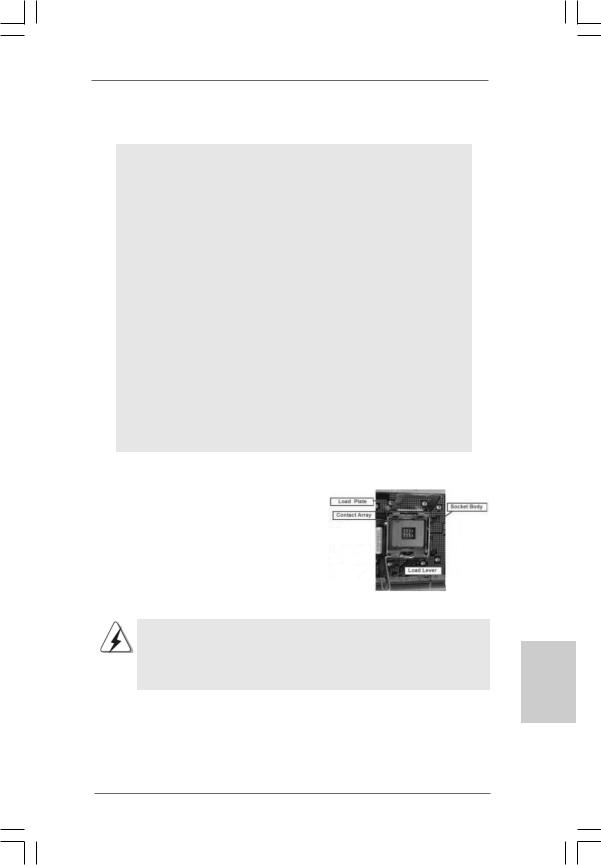
2. Installation
Pre-installation Precautions
Take note of the following precautions before you install motherboard components or change any motherboard settings.
1.Unplug the power cord from the wall socket before touching any component. Failure to do so may cause severe damage to the motherboard, peripherals, and/or components.
2.To avoid damaging the motherboard components due to static electricity, NEVER place your motherboard directly on the carpet or the like. Also remember to use a grounded wrist strap or touch a safety grounded object before you handle components.
3.Hold components by the edges and do not touch the ICs.
4.Whenever you uninstall any component, place it on a grounded antstatic pad or in the bag that comes with the component.
5.When placing screws into the screw holes to secure the motherboard to the chassis, please do not over-tighten the screws! Doing so may damage the motherboard.
2.1CPU Installation
For the installation of Intel 775-LAND CPU, please follow the steps below.
775-Pin Socket Overview
Before you insert the 775-LAND CPU into the socket, please check if the CPU surface is unclean or if there is any bent pin on the socket. Do not force to insert the CPU into the socket if above situation is found. Otherwise, the CPU will be seriously damaged.
9
English
ASRock G41M-GS Motherboard

Step 1. Open the socket:
Step 1-1. Disengaging the lever by depressing down and out on the hook to clear retention tab.
English
Step 1-2. Rotate the load lever to fully open position at approximately 135 degrees.
Step 1-3. Rotate the load plate to fully open position at approximately 100 degrees.
Step 2. Insert the 775-LAND CPU:
Step 2-1. Hold the CPU by the edges where are marked with black lines.
Step 2-2. Orient the CPU with IHS (Integrated Heat Sink) up. Locate Pin1 and the two orientation key notches.
lineblack |
lineblack |
Pin1 |
|
Pin1 |
|
|
|
alignment key |
|
orientation |
orientation |
alignment key |
|
|
|
||
key notch |
key notch |
|
|
|
|
|
775-Pin Socket |
|
775-LAND CPU |
|
|
For proper inserting, please ensure to match the two orientation key notches of the CPU with the two alignment keys of the socket.
Step 2-3. Carefully place the CPU into the socket by using a purely vertical motion.
Step 2-4. Verify that the CPU is within the socket and properly mated to the orient keys.
Step 3. Remove PnP Cap (Pick and Place Cap):
Use your left hand index finger and thumb to support the load plate edge, engage PnP cap with right hand thumb and peel the cap from the socket while pressing on center of PnP cap to assist in removal.
1 0
ASRock G41M-GS Motherboard

1.It is recommended to use the cap tab to handle and avoid kicking off the PnP cap.
2.This cap must be placed if returning the motherboard for after service.
Step 4. Close the socket:
Step 4-1. Rotate the load plate onto the IHS. Step 4-2. While pressing down lightly on load
plate, engage the load lever.
Step 4-3. Secure load lever with load plate tab under retention tab of load lever.
2.2Installation of CPU Fan and Heatsink
For proper installation, please kindly refer to the instruction manuals of your CPU fan and heatsink.
Below is an example to illustrate the installation of the heatsink for 775-LAND CPU. Step 1. Apply thermal interface material onto center
of IHS on the socket surface.
Step 2. |
Place the heatsink onto the socket. Ensure |
|
fan cables are oriented on side closest to the |
|
CPU fan connector on the motherboard |
|
(CPU_FAN1, see page 2, No. 4). |
Step 3. |
Align fasteners with the motherboard |
|
throughholes. |
Step 4. |
Rotate the fastener clockwise, then press |
|
down on fastener caps with thumb to install |
|
and lock. Repeat with remaining fasteners. |
|
|
|
If you press down the fasteners without rotating them clockwise, |
|
the heatsink cannot be secured on the motherboard. |
|
|
Step 5. |
Connect fan header with the CPU fan |
|
connector on the motherboard. |
Step 6. |
Secure excess cable with tie-wrap to ensure |
|
cable does not interfere with fan operation or |
|
contact other components. |
English
1 1
ASRock G41M-GS Motherboard
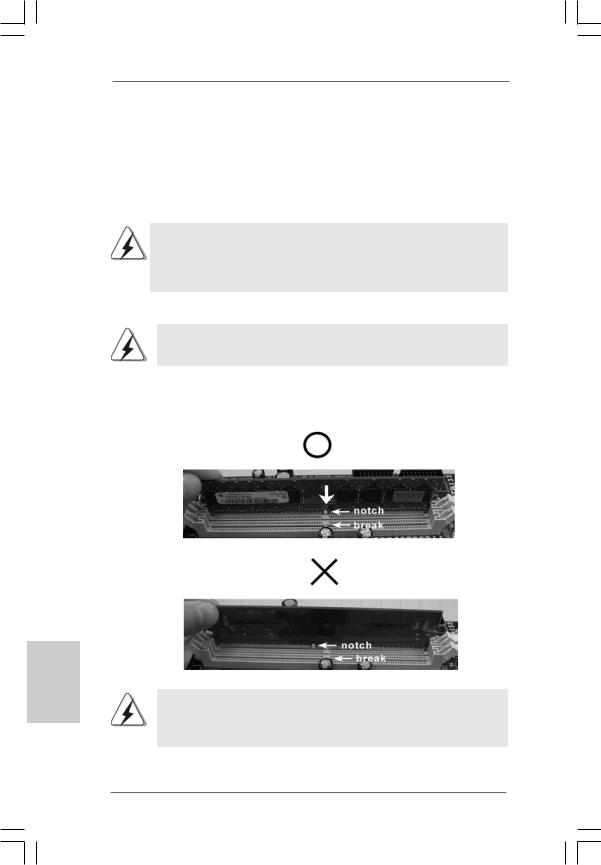
English
2.3 Installation of Memory Modules (DIMM)
G41M-GS motherboard provides two 240-pin DDR2 (Double Data Rate 2) DIMM slots, and supports Dual Channel Memory Technology. For dual channel configuration, you always need to install two identical (the same brand, speed, size and chiptype) memory modules in the DDR2 DIMM slots to activate Dual Channel Memory Technology. Otherwise, it will operate at single channel mode.
1.It is not allowed to install a DDR memory module into DDR2 slot; otherwise, this motherboard and DIMM may be damaged.
2.If you install only one memory module or two non-identical memory modules, it is unable to activate the Dual Channel Memory Technology.
Installing a DIMM
Please make sure to disconnect power supply before adding or removing DIMMs or the system components.
Step 1. Unlock a DIMM slot by pressing the retaining clips outward.
Step 2. Align a DIMM on the slot such that the notch on the DIMM matches the break on the slot.
The DIMM only fits in one correct orientation. It will cause permanent damage to the motherboard and the DIMM if you force the DIMM into the slot at incorrect orientation.
Step 3. Firmly insert the DIMM into the slot until the retaining clips at both ends fully snap back in place and the DIMM is properly seated.
1 2
ASRock G41M-GS Motherboard

2.4 Expansion Slots (PCI and PCI Express Slots)
There are 2 PCI slots and 2 PCI Express slots on this motherboard.
PCI slots: PCI slots are used to install expansion cards that have the 32-bit PCI interface.
PCIE slots:
PCIE1 (PCIE x1 slot) is used for PCI Express cards with x1 lane width cards, such as Gigabit LAN card, SATA2 card, etc.
PCIE2 (PCIE x16 slot) is used for PCI Express cards with x16 lane width graphics cards.
If you install the add-on PCI Express VGA card to PCIE2 (PCIE x16 slot), the onboard VGA will be disabled. If you install the add-on PCI Express VGA card to PCIE2 (PCIE x16 slot) and adjust the BIOS options “Primary Graphics Adapter” to [Onboard] and “Share Memory” to [Auto], then the onboard VGA will be enabled, and the primary screen will be onboard VGA.
Installing an expansion card
Step 1. Before installing the expansion card, please make sure that the power supply is switched off or the power cord is unplugged. Please read the documentation of the expansion card and make necessary hardware settings for the card before you start the installation.
Step 2. Remove the bracket facing the slot that you intend to use. Keep the screws for later use.
Step 3. Align the card connector with the slot and press firmly until the card is completely seated on the slot.
Step 4. Fasten the card to the chassis with screws.
English
1 3
ASRock G41M-GS Motherboard

English
2.5 Jumpers Setup
The illustration shows how jumpers are |
|
|
||
setup. When the jumper cap is placed on |
|
|
||
pins, the jumper is “Short”. If no jumper cap |
|
|
||
is placed on pins, the jumper is “Open”. The |
|
|
||
illustration shows a 3-pin jumper whose pin1 |
Short |
Open |
||
and pin2 are “Short” when jumper cap is |
||||
|
|
|||
placed on these 2 pins. |
|
|
|
|
Jumper |
Setting |
|
Description |
|
PS2_USB_PWR1 |
|
|
Short pin2, pin3 to enable |
|
(see p.2 No. 1) |
|
|
+5VSB (standby) for PS/2 |
|
|
|
|
or USB wake up events. |
|
Note: To select +5VSB, it requires 2 Amp and higher standby current provided by power supply.
Clear CMOS
(CLRCMOS1, 2-pin jumper)
(see p.2 No. 8) 2-pin jumper
Note: CLRCMOS1 allows you to clear the data in CMOS. The data in CMOS includes system setup information such as system password, date, time, and system setup parameters. To clear and reset the system parameters to default setup, please turn off the computer and unplug the power cord from the power supply. After waiting for 15 seconds, use a jumper cap to short 2 pins on CLRCMOS1 for 5 seconds.
EUP LAN / EUP Audio Jumper
(EUP_LAN1, 3-pin jumper, see p.2 No. 22) |
Default (Enable EuP) |
(EUP_AUDIO1, 3-pin jumper, see p.2 No. 21) |
Note: EUP_LAN and EUP_AUDIO jumper design decreases the power consumption of this motherboard to meet EuP standard. With an ASRock EuP ready motherboard and a power supply that the 5VSB power efficiency is higher than 50% under 100mA current consumption, your system is able to submit EuP standard. The default setting (short pin1 and pin2) is EuP enabled. If you want to disable this power saving function, you may short pin2 and pin3. Please be noticed that when EUP_LAN jumper is set to enabled, the Wake-On-LAN function under S3 (Suspend to RAM), S4 (Suspend to Disk), and S5 (Soft Off) will be disabled.
(Disable EuP)
1 4
ASRock G41M-GS Motherboard

(Enable EuP)
uP)
FSB1 / FSB2 / FSB3 Jumper
(FSB1 / FSB2 / FSB3, 3-pin jumper, see p.2 No. 28)
Default
Standard Setting:
If you adopt below DRAM / CPU configuration on this motherboard, you need to adjust the jumpers. Please follow the instructions below to set up the jumpers. Otherwise, the CPU and memory module may not work properly on this motherboard.
DRAM |
DDR2 533 |
DDR2 1066 |
|
CPU |
FSB533 |
FSB1066 |
FSB1333 |
Jumper |
|
|
|
Settings |
|
|
|
|
FSB1: 2-3 |
FSB1: 1-2 |
FSB1: 1-2 |
|
FSB2: 1-2 |
FSB2: 1-2 |
FSB2: 4-5 |
|
FSB3: 2-3 |
FSB3: 2-3 |
FSB3: 1-2 |
|
|
|
|
Overclocking Setting:
When you mount a FSB800 or FSB1066 CPU, and try to overclock to FSB1333 (by BIOS setting) you may face the problem, that DRAM frequency will be overclocked very high. Please use jumper to force NB to be strapped at higher frequency, so the DRAM can work at lower frequency.
If you want to overclock the CPU you adopt to FSB1066 on this motherboard, you need to adjust the jumpers. Please short pin4, pin5 for FSB2 jumper and pin4, pin5 for FSB3 jumper. Otherwise, the CPU may not work properly on this motherboard. Please refer to below jumper settings.
If you want to overclock the CPU you adopt to FSB1333 on this motherboard, you |
English |
|
|
need to adjust the jumpers. Please short pin3, pin4 for FSB2 jumper and pin4, pin5 for |
|
FSB3 jumper. Otherwise, the CPU may not work properly on this motherboard. |
|
Please refer to below jumper settings. |
|
|
1 5
ASRock G41M-GS Motherboard
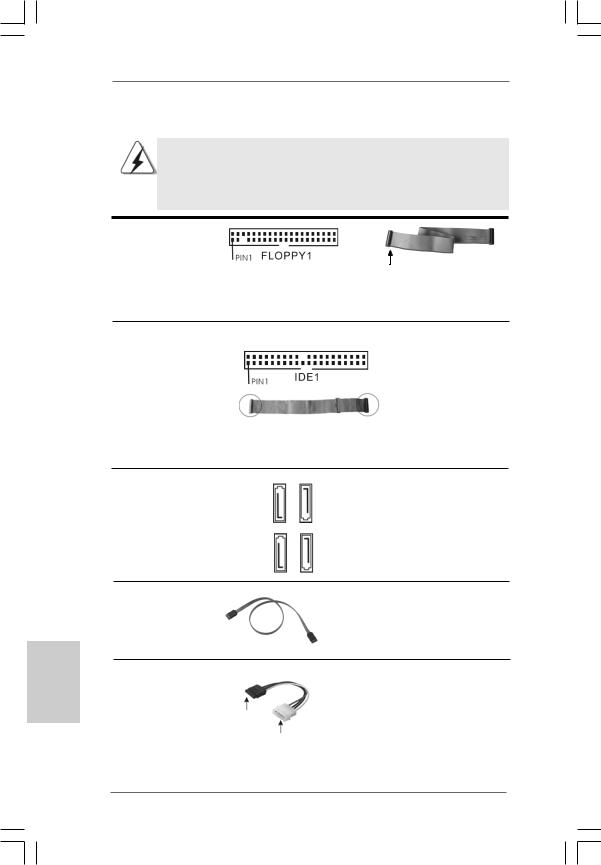
English
2.6 Onboard Headers and Connectors
Onboard headers and connectors are NOT jumpers. Do NOT place jumper caps over these headers and connectors. Placing jumper caps over the headers and connectors will cause permanent damage of the motherboard!
FDD connector
(33-pin FLOPPY1)
(see p.2 No. 20)
the red-striped side to Pin1
Note: Make sure the red-striped side of the cable is plugged into Pin1 side of the connector.
Primary IDE connector (Blue)
(39-pin IDE1, see p.2 No. 7)
connect the blue end |
connect the black end |
to the motherboard |
to the IDE devices |
|
80-conductor ATA 66/100 cable |
Note: Please refer to the instruction of your IDE device vendor for the details.
Serial ATAII Connectors
(SATAII_1: see p.2, No. 13) (SATAII_2: see p.2, No. 12) (SATAII_3: see p.2, No. 10) (SATAII_4: see p.2, No. 11)
Serial ATA (SATA) Data Cable
(Optional)
SATAII 3 |
SATAII 4 |
SATAII 1 |
SATAII 2 |
These four Serial ATAII (SATAII) connectors support SATA data cables for internal storage devices. The current SATAII interface allows up to 3.0 Gb/s data transfer rate.
Either end of the SATA data cable can be connected to the SATA / SATAII hard disk or the SATAII connector on the motherboard.
Serial ATA (SATA) Power Cable
(Optional)
connect to the SATA
HDD power connector
connect to the powersupply
Please connect the black end of SATA power cable to the power connector on each drive. Then connect the white end of SATA power cable to the power connector of the power supply.
1 6
ASRock G41M-GS Motherboard
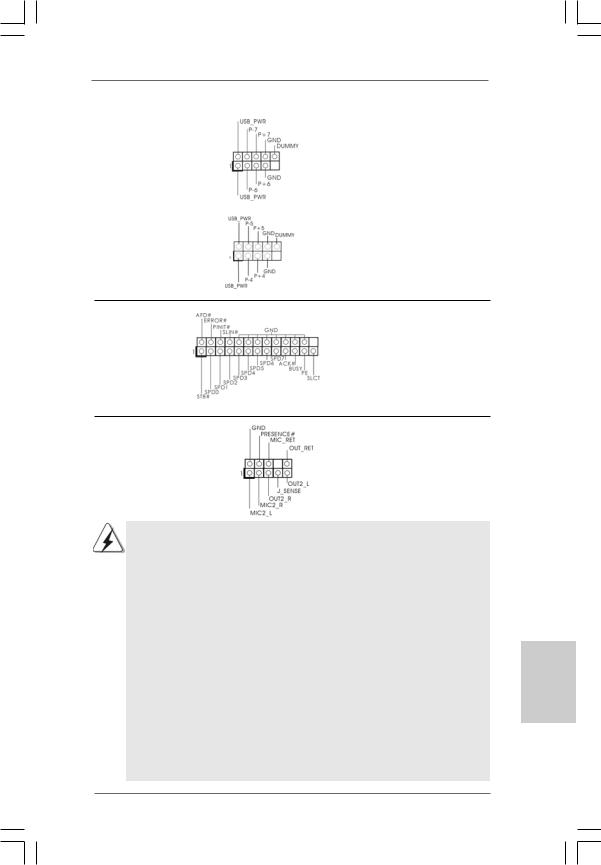
USB 2.0 Headers |
Besides four default USB 2.0 |
(9-pin USB6_7) |
ports on the I/O panel, there are |
(see p.2 No. 15) |
two USB 2.0 headers on this |
|
motherboard. Each USB 2.0 |
|
header can support two USB |
|
2.0 ports. |
(9-pin USB4_5) |
|
(see p.2 No. 16) |
|
Print Port Header |
This is an interface for print |
(25-pin LPT1) |
port cable that allows |
(see p.2 No. 27) |
convenient connection of printer |
|
devices. |
Front Panel Audio Header |
This is an interface for front |
(9-pin HD_AUDIO1) |
panel audio cable that allows |
(see p.2 No. 23) |
convenient connection and |
|
control of audio devices. |
1.High Definition Audio supports Jack Sensing, but the panel wire on the chassis must support HDA to function correctly. Please follow the instruction in our manual and chassis manual to install your system.
2.If you use AC’97 audio panel, please install it to the front panel audio header as below:
A.Connect Mic_IN (MIC) to MIC2_L.
B.Connect Audio_R (RIN) to OUT2_R and Audio_L (LIN) to OUT2_L.
C.Connect Ground (GND) to Ground (GND).
D.MIC_RET and OUT_RET are for HD audio panel only. You don’t need to connect them for AC’97 audio panel.
E.Enter BIOS Setup Utility. Enter Advanced Settings, and then select Chipset Configuration. Set the Front Panel Control option from [Auto] to [Enabled].
F.Enter Windows system. Click the icon on the lower right hand taskbar to enter Realtek HD Audio Manager.
For Windows® 2000 / XP / XP 64-bit OS:
Click “Audio I/O”, select “Connector Settings”  , choose
, choose
English
1 7
ASRock G41M-GS Motherboard

“Disable front panel jack detection”, and save the change by
clicking “OK”. |
|
For Windows® VistaTM / VistaTM 64-bit OS: |
|
Click the right-top “Folder” icon |
, choose “Disable front |
panel jack detection”, and save the change by clicking “OK”. G. To activate the front mic.
For Windows® 2000 / XP / XP 64-bit OS:
Please select “Front Mic” as default record device.
If you want to hear your voice through front mic, please deselect "Mute" icon in “Front Mic” of “Playback” portion.
For Windows® VistaTM / VistaTM 64-bit OS:
Go to the "Front Mic" Tab in the Realtek Control panel.
Click "Set Default Device" to make the Front Mic as the default record device.
System Panel Header |
This header accommodates |
(9-pin PANEL1) |
several system front panel |
(see p.2 No. 17) |
functions. |
English
Chassis Speaker Header |
|
Please connect the chassis |
(4-pin SPEAKER 1) |
|
speaker to this header. |
(see p.2 No. 14) |
|
|
|
|
|
Chassis Fan Connector |
|
Please connect a chassis fan |
(3-pin CHA_FAN1) |
|
cable to this connector and |
(see p.2 No. 19) |
|
match the black wire to the |
|
|
ground pin. |
|
|
|
CPU Fan Connector |
4 3 2 1 |
Please connect a CPU fan cable |
(4-pin CPU_FAN1) |
|
to this connector and match |
(see p.2 No. 4) |
|
the black wire to the ground pin. |
Though this motherboard provides 4-Pin CPU fan (Quiet Fan) support, the 3-Pin CPU fan still can work successfully even without the fan speed control function. If you plan to connect the 3-Pin CPU fan to the CPU fan connector on this motherboard, please connect it to Pin 1-3.
Pin 1-3 Connected
3-Pin Fan Installation
1 8
ASRock G41M-GS Motherboard

ATX Power Connector |
12 |
24 |
Please connect an ATX power |
|||
(24-pin ATXPWR1) |
|
|
supply to this connector. |
|
||
(see p.2 No. 6) |
|
|
|
|
|
|
|
|
1 |
13 |
|
|
|
|
|
|
|
|||
|
Though this motherboard provides 24-pin ATX power connector, |
12 |
24 |
|||
|
it can still work if you adopt a traditional 20-pin ATX power supply. |
|
|
|||
|
To use the 20-pin ATX power supply, please plug your power |
|
|
|||
|
supply along with Pin 1 and Pin 13. |
|
|
|
||
|
|
|
20-PinATX Power Supply Installation |
1 |
13 |
|
|
|
|
|
|
||
|
|
|
|
|||
ATX 12V Connector |
|
|
Please note that it is necessary |
|||
(4-pin ATX12V1) |
|
|
to connect a power supply with |
|||
(see p.2 No. 29) |
|
|
ATX 12V plug to this connector |
|||
|
|
|
|
so that it can provides sufficient |
||
|
|
|
|
power. Failing to do so will cause |
||
|
|
|
|
the failure to power up. |
|
|
English
ion
1 9
ASRock G41M-GS Motherboard

2.7Serial ATA (SATA) / Serial ATAII (SATAII) Hard Disks
Installation
This motherboard adopts Intel® ICH7 south bridge chipset that supports Serial ATA (SATA) / Serial ATAII (SATAII) hard disks. You may install SATA / SATAII hard disks on this motherboard for internal storage devices. This section will guide you to install the SATA / SATAII hard disks.
STEP 1: Install the SATA / SATAII hard disks into the drive bays of your chassis. STEP 2: Connect the SATA power cable to the SATA / SATAII hard disk.
STEP 3: Connect one end of the SATA data cable to the motherboard’s SATAII connector.
STEP 4: Connect the other end of the SATA data cable to the SATA / SATAII hard disk.
2.8Driver Installation Guide
To install the drivers to your system, please insert the support CD to your optical drive first. Then, the drivers compatible to your system can be auto-detected and listed on the support CD driver page. Please follow the order from up to bottom side to install those required drivers. Therefore, the drivers you install can work properly.
2.9Untied Overclocking Technology
This motherboard supports Untied Overclocking Technology, which means during overclocking, FSB enjoys better margin due to fixed PCI / PCIE buses. Before you enable Untied Overclocking function, please enter “Overclock Mode” option of BIOS setup to set the selection from [Auto] to [Manual]. Therefore, CPU FSB is untied during overclocking, but PCI / PCIE buses are in the fixed mode so that FSB can operate under a more stable overclocking environment.
Please refer to the warning on page 7 for the possible overclocking risk before you apply Untied Overclocking Technology.
English
2 0
ASRock G41M-GS Motherboard

3. BIOS Information
The Flash Memory on the motherboard stores BIOS Setup Utility. When you start up the computer, please press <F2> during the Power-On-Self-Test (POST) to enter BIOS Setup utility; otherwise, POST continues with its test routines. If you wish to enter BIOS Setup after POST, please restart the system by pressing <Ctl> + <Alt> + <Delete>, or pressing the reset button on the system chassis. The BIOS Setup program is designed to be user-friendly. It is a menu-driven program, which allows you to scroll through its various sub-menus and to select among the predetermined choices. For the detailed information about BIOS Setup, please refer to the User Manual (PDF file) contained in the Support CD.
4. Software Support CD information
This motherboard supports various Microsoft® Windows® operating systems: 2000 / XP / XP 64-bit / VistaTM / VistaTM 64-bit. The Support CD that came with the motherboard contains necessary drivers and useful utilities that will enhance motherboard features. To begin using the Support CD, insert the CD into your CD-ROM drive. It will display the Main Menu automatically if “AUTORUN” is enabled in your computer. If the Main Menu does not appear automatically, locate and double-click on the file “ASSETUP. EXE” from the BIN folder in the Support CD to display the menus.
English
2 1
ASRock G41M-GS Motherboard

1. Einführung
Wir danken Ihnen für den Kauf des ASRock G41M-GS Motherboard, ein zuverlässiges Produkt, welches unter den ständigen, strengen Qualitätskontrollen von ASRock gefertigt wurde. Es bietet Ihnen exzellente Leistung und robustesDesign, gemäß der Verpflichtung von ASRock zu Qualität und Halbarkeit.
Diese Schnellinstallationsanleitung führt in das Motherboard und die schrittweise Installation ein. Details über das Motherboard finden Sie in der Bedienungsanleitung auf der Support-CD.
Da sich Motherboard-Spezifikationen und BIOS-Software verändern können, kann der Inhalt dieses Handbuches ebenfalls jederzeit geändert werden. Für den Fall, dass sich Änderungen an diesem Handbuch ergeben, wird eine neue Version auf der ASRock-Website, ohne weitere Ankündigung, verfügbar sein. Die neuesten Grafikkarten und unterstützten CPUs sind auch auf der ASRock-Website aufgelistet.
ASRock-Website: http://www.asrock.com
Wenn Sie technische Unterstützung zu Ihrem Motherboard oder spezifische Informationen zu Ihrem Modell benötigen, besuchen Sie bitte unsere Webseite:
www.asrock.com/support/index.asp
1.1 Kartoninhalt
ASRock G41M-GS Motherboard
(Micro ATX-Formfaktor: 24.4 cm x 19.3 cm; 9.6 Zoll x 7.6 Zoll)
ASRock G41M-GS Schnellinstallationsanleitung
ASRock G41M-GS Support-CD
Ein 80-adriges Ultra-ATA 66/100 IDE-Flachbandkabel (optional)
Ein Serial ATA (SATA) -Datenkabel (optional)
Ein I/O Shield
Deutsch
2 2
ASRock G41M-GS Motherboard

1.2 Spezifikationen
Plattform |
- Micro ATX-Formfaktor: 24.4 cm x 19.3 cm; 9.6 Zoll x 7.6 Zoll |
CPU |
- LGA 775 für Intel® CoreTM 2 Extreme / CoreTM 2 Quad / CoreTM |
|
2 Duo / Pentium® Dual Core / Celeron® Dual Core / Celeron® |
|
unterstützt Penryn Quad Core Yorkfield und Dual Core |
|
Wolfdale Prozessoren |
|
- FSB1333/1066/800/533 MHz (siehe VORSICHT 1) |
|
- Unterstützt Hyper-Threading-Technologie (siehe VORSICHT 2) |
|
- Unterstützt Untied-Übertaktungstechnologie |
|
(siehe VORSICHT 3) |
|
- Unterstützt EM64T-CPU |
Chipsatz |
- Northbridge: Intel® G41 |
|
- Southbridge: Intel® ICH7 |
Speicher |
- Unterstützung von Dual-Kanal-DDR2-Speichertechnologie |
|
(siehe VORSICHT 4) |
|
- 2 x Steckplätze für DDR2 |
|
- Unterstützt DDR2 1066/800/667/533 non-ECC, ungepufferter |
|
Speicher (siehe VORSICHT 5) |
|
- Max. Kapazität des Systemspeichers: 8GB |
|
(siehe VORSICHT 6) |
Erweiterungs- |
- 1 x PCI Express x16-Steckplätze |
steckplätze |
- 1 x PCI Express x1-Steckplätze |
|
- 2 x PCI -Steckplätze |
Onboard-VGA |
- Intel® Grafikmedienbeschleuniger X4500 |
|
- Pixel Shader 4.0, DirectX 10 |
|
- Maximal gemeinsam genutzter Speicher 352MB |
|
(siehe VORSICHT 7) |
Audio |
- 5.1 CH Windows® VistaTM Premium Level HD Audio |
|
(Realtek ALC662 Audio Codec) |
LAN |
- PCIE x1 Gigabit LAN 10/100/1000 Mb/s |
|
- Realtek RTL8111DL |
|
- Unterstützt Wake-On-LAN |
E/A-Anschlüsse |
I/O Panel |
an der |
- 1 x PS/2-Mausanschluss |
Rückseite |
- 1 x PS/2-Tastaturanschluss |
|
- 1 x Serieller port: COM 1 |
|
- 1 x VGA Port |
|
- 4 x Standard-USB 2.0-Anschlüsse |
|
- 1 x RJ-45 LAN Port mit LED (ACT/LINK LED und SPEED LED) |
|
- Audioanschlüsse: Line In / Line Out / Mikrofon |
Deutsch
2 3
ASRock G41M-GS Motherboard

Deutsch
Anschlüsse |
- 4 x SATAII-Anschlüsse, unterstützt bis 3.0 Gb/s |
|
Datenübertragungsrate (Unterstützt keine “RAID”- und “Hot- |
|
Plug”-Funktionen) (siehe VORSICHT 8) |
|
- 1 x ATA100 IDE-Anschlüsse (Unterstützt bis 2 IDE-Geräte) |
|
- 1 x FDD-Anschlüsse |
|
- 1 x Druckerport-Anschlussleiste |
|
- CPU/Gehäuse-Lüfteranschluss |
|
- 24-pin ATX-Netz-Header |
|
- 4-pin anschluss für 12V-ATX-Netzteil |
|
- Anschluss für Audio auf der Gehäusevorderseite |
|
- 2 x USB 2.0 Buchse (unterstützt 4 USB 2.0 Ports) |
|
(siehe VORSICHT 9) |
BIOS |
- 8Mb AMI BIOS |
|
- AMI legal BIOS mit Unterstützung für “Plug and Play” |
|
- ACPI 1.1-Weckfunktionen |
|
- SMBIOS 2.3.1 |
|
- Unterstützt Smart BIOS |
Support-CD |
- Treiber, Dienstprogramme, Antivirussoftware |
|
(Probeversion) |
Einzigartige |
- ASRock OC Tuner (siehe VORSICHT 10) |
Eigenschaft |
- Intelligent Energy Saver (Intelligente Energiesparfunktion) |
|
(siehe VORSICHT 11) |
|
- Sofortstart |
|
- ASRock Instant Flash (siehe VORSICHT 12) |
|
- Hybrid Booster: |
|
- Schrittloser CPU-Frequenz-Kontrolle |
|
(siehe VORSICHT 13) |
|
- ASRock U-COP (siehe VORSICHT 14) |
|
- Boot Failure Guard (B.F.G. – Systemstartfehlerschutz) |
Hardware Monitor - Überwachung der CPU-Temperatur
|
- Motherboardtemperaturerkennung |
|
- Drehzahlmessung für CPU-Lüfter |
|
- Drehzahlmessung für Gehäuselüfter |
|
- CPU-Lüftergeräuschdämpfung |
|
- Spannungsüberwachung: +12V, +5V, +3.3V, Vcore |
Betriebssysteme |
- Unterstützt Microsoft® Windows® 2000 / XP / XP 64-Bit / |
|
VistaTM / VistaTM 64-Bit |
Zertifizierungen |
- FCC, CE |
-Gemäß Ökodesign-Richtlinie (EuP) (Stromversorgung gemäß Ökodesign-Richtlinie (EuP) erforderlich) (siehe VORSICHT 15)
*Für die ausführliche Produktinformation, besuchen Sie bitte unsere Website: http://www.asrock.com
2 4
ASRock G41M-GS Motherboard

WARNUNG
Beachten Sie bitte, dass Overclocking, einschließlich der Einstellung im BIOS, Anwenden der Untied Overclocking-Technologie oder Verwenden von Overclocking-Werkzeugen von Dritten, mit einem gewissen Risiko behaftet ist. Overclocking kann sich nachteilig auf die Stabilität Ihres Systems auswirken oder sogar Komponenten und Geräte Ihres Systems beschädigen. Es geschieht dann auf eigene Gefahr und auf Ihre Kosten. Wir übernehmen keine Verantwortung für mögliche Schäden, die aufgrund von Overclocking verursacht wurden.
VORSICHT!
1. Dieses Motherboard unterstützt FSB1333/1066/800 MHz. Im Normalbetrieb müssen Sie keine Steckbrückeneinstellungen (Jumper) ändern. Spezielle Steckbrückeneinstellungen zum Übertakten finden Sie auf Seite 28 und 29.
2. Die Einstellung der “Hyper-Threading Technology”, finden Sie auf Seite 31 des auf der Support-CD enthaltenen Benutzerhandbuches beschrieben.
3. Dieses Motherboard unterstützt die Untied-Übertaktungstechnologie. Unter “Entkoppelte Übertaktungstechnologie” auf Seite 20 finden Sie detaillierte Informationen.
4. Dieses Motherboard unterstützt Dual-Kanal-Speichertechnologie. Vor Implementierung der Dual-Kanal-Speichertechnologie müssen Sie die Installationsanleitung für die Speichermodule auf Seite 12 zwecks richtiger Installation gelesen haben.
5. Die unterstützten Arbeitsspeicherfrequenzen und die entsprechende CPU FSB-Frequenz entnehmen Sie bitte der nachstehenden Tabelle.
CPU FSB-Frequenz |
Unterstützte Arbeitsspeicherfrequenz |
1333 |
DDR2 667, DDR2 800, DDR2 1066 |
1066 |
DDR2 667, DDR2 800, DDR2 1066 |
800 |
DDR2 667, DDR2 800 |
533 |
DDR2 533 |
* DDR2 1066 Speichermodule werden in Übertakten Modus funktionieren.
* Wenn Sie einen DDR2 1066 Speichermodul adoptieren auf dieser Hauptplatine adoptieren, müssen Sie die Steckbrücke regulieren. Bitte beziehen Sie sich auf Seite 28 und 29 für korrekte Steckbrücke Einstellungen.
6. Durch Betriebssystem-Einschränkungen kann die tatsächliche Speichergröße weniger als 4 GB betragen, da unter Windows® XP und Windows® Vista™ etwas Speicher zur Nutzung durch das System reserviert wird. Unter Windows® XP 64-bit und Windows® Vista™ 64-bit mit 64-Bit-CPU besteht diese Einschränkung nicht.
7. Die Maximalspeichergröße ist von den Chipshändler definiert und umgetauscht. Bitte überprüfen Sie Intel® website für die neuliche Information.
Deutsch
2 5
ASRock G41M-GS Motherboard

Deutsch
2 6
8.Vor Installation der SATAII-Festplatte an den SATAII-Anschluss lesen Sie bitte “Setup-Anleitung für SATAII-Festplatte” auf Seite 24 der “Bedienungsanleitung” auf der Support-CD, um Ihre SATAII-Festplatte dem SATAII-Modus anzugleichen. Sie können die SATA-Festplatte auch direkt mit dem SATAII-Anschluss verbinden.
9.Das Power Management für USB 2.0 arbeitet unter Microsoft® Windows® VistaTM 64-Bit / VistaTM / XP 64-Bit / XP SP1 oder SP2/2000 SP4 einwandfrei.
10.Es ist ein benutzerfreundlicher ASRock Übertaktenswerkzeug, das erlaubt, dass Sie Ihr System durch den Hardware-Monitor Funktion zu überblicken und Ihre Hardware-Geräte übertakten, um die beste Systemleistung unter der Windows® Umgebung zu erreichen. Besuchen Sie bitte unsere Website für die Operationsverfahren von ASRock OC Tuner. ASRock-Website: http://www.asrock.com
11.Mit einem fortschrittlichen, eigenständigen Hardund Softwaredesign nutzt der Intelligent Energy Saver eine revolutionäre Technologie, die bisher unerreichte Energieeinsparungen ermöglicht. Mit anderen Worten: Sie verbrauchen besonders wenig Energie und erreichen einen hohen Wirkungsgrad, ohne dass dies zu Lasten der Rechenleistung geht. Auf unseren Internetseiten finden Sie einige Erläuterungen zur Funktionsweise des Intelligent Energy Saver.
ASRock-Website: http://www.asrock.com
12.ASRock Instant Flash ist ein im Flash-ROM eingebettetes BIOS-Flash- Programm. Mithilfe dieses praktischen BIOS-Aktualisierungswerkzeugs können Sie das System-BIOS aktualisieren, ohne dafür zuerst Betriebssysteme wie MS-DOS oder Windows® aufrufen zu müssen. Mit diesem Programm bekommen Sie durch Drücken der <F6>-Taste während des POST-Vorgangs oder durch Drücken der <F2>-Taste im BIOS-Setup-Menü Zugang zu ASRock Instant Flash. Sie brauchen dieses Werkzeug einfach nur zu starten und die neue BIOS-Datei auf Ihrem USB-Flash-Laufwerk, Diskettenlaufwerk oder der Festplatte zu speichern, und schon können Sie Ihr BIOS mit nur wenigen Klickvorgängen ohne Bereitstellung einer zusätzlichen Diskette oder eines anderen komplizierten Flash-Programms aktualisieren. Achten Sie darauf, dass das USB-Flash-Laufwerk oder die Festplatte das Dateisystem FAT32/16/12 benutzen muss.
13.Obwohl dieses Motherboard stufenlose Steuerung bietet, wird Overclocking nicht empfohlen. Frequenzen, die von den empfohlenen CPU-Busfrequenzen abweichen, können Instabilität des Systems verursachen oder die CPU beschädigen.
14.Wird eine Überhitzung der CPU registriert, führt das System einen automatischen Shutdown durch. Bevor Sie das System neu starten, prüfen Sie bitte, ob der CPU-Lüfter am Motherboard richtig funktioniert, und stecken Sie bitte den Stromkabelstecker aus und dann wieder ein. Um die Wärmeableitung zu verbessern, bitte nicht vergessen, etwas Wärmeleitpaste zwischen CPU und Kühlkörper zu sprühen.
ASRock G41M-GS Motherboard

15.EuP steht für Energy Using Product und kennzeichnet die ÖkodesignRichtlinie, die von der Europäischen Gemeinschaft zur Festlegung des Energieverbrauchs von vollständigen Systemen in Kraft gesetzt wurde. Gemäß dieser Ökodesign-Richtlinie (EuP) muss der gesamte Netzstromverbrauch von vollständigen Systemen unter 1,00 Watt liegen, wenn sie ausgeschaltet sind. Um dem EuP-Standard zu entsprechen, sind ein EuP-fähiges Motherboard und eine EuP-fähige Stromversorgung erforderlich. Gemäß einer Empfehlung von Intel muss eine EuP-fähige Stromversorgung dem Standard entsprechen, was bedeutet, dass bei einem Stromverbrauch von 100 mA die 5-Volt-Standby-Energieeffizienz höher als 50% sein sollte. Für die Wahl einer EuP-fähigen Stromversorgung empfehlen wir Ihnen, weitere Details beim Hersteller der Stromversorgung abzufragen.
1.3Einstellung der Jumper
Die Abbildung verdeutlicht, wie Jumper gesetzt werden. Werden Pins durch Jumperkappen verdeckt, ist der Jumper “Gebrückt”. Werden keine Pins durch
Jumperkappen verdeckt, ist der Jumper Gebrückt Offen “Offen”. Die Abbildung zeigt einen 3-Pin
Jumper dessen Pin1 und Pin2 “Gebrückt” sind, bzw. es befindet sich eine JumperKappe auf diesen beiden Pins.
Einstellun Beschreibung
Überbrücken Sie Pin2, Pin3, um +5VSB (Standby) zu setzen und die PS/2 oder USBWeckfunktionen zu aktivieren.
Um +5VSB nutzen zu können, muss das Netzteil auf dieser Leitung 2A oder mehr leisten können.
CMOS löschen
(CLRCMOS1, 2-Pin jumper)
(siehe S.2 - No. 8) 2-Pin jumper
Hinweis: Mit CLRCMOS1 können Sie die Daten im CMOS löschen. Die CMOS Daten beinhalten die Systeminformationen wie Systemkennwort, Datum, Zeit und System-Setupeinstellungen. Um die Einstellungen zu löschen und Default-Werte wiederherzustellen, schalten Sie den Computer aus, ziehen Sie den Netzstecker und überbrücken Sie 2-pin von CLRCMOS1 mithilfe des Jumpers für 5 Sekunden.
2 7
Deutsch
ASRock G41M-GS Motherboard
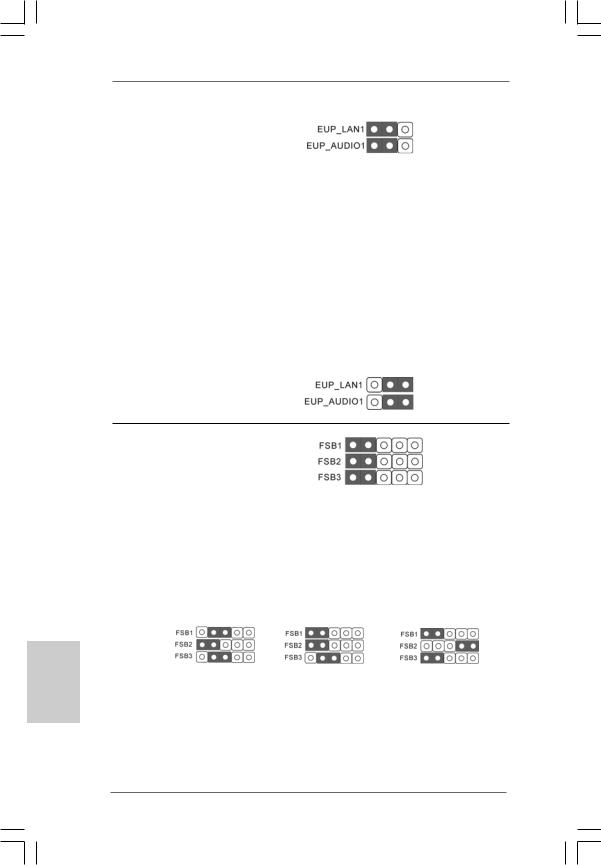
EUP LAN / EUP-Audio-Jumper |
|
|
(EUP_LAN1, 3-pol. Jumper, siehe Seite 2, Nr. 22) |
Standard (EuP aktivieren) |
|
(EUP_AUDIO1, 3-pol. Jumper, siehe Seite 2, Nr. 21) |
||
|
Hinweis: Das Jumper-Design EUP_LAN und EUP_AUDIO verringert den Energieverbrauch dieses Motherboards, um dem Standard der Ökodesign-Richtlinie (EuP) zu entsprechen. Mit einem ASRockMotherboard gemäß der Ökodesign-Richtlinie (EuP) und einer Stromversorgung, deren 5 VSB-Energieeffizienz der Standby-Spannung bei einer Stromaufnahme von 100 mA höher ist als 50%, ist Ihr System befähigt, sich dem Standard der Ökodesign-Richtlinie (EuP) auszusetzen. Die Standardeinstellung ist EuP-aktiviert (Pin 1 und Pin 2 sind geschlossen). Möchten Sie diese Energiesparfunktion deaktivieren, müssen Sie Pin 2 und Pin 3 schließen. Wird der EUP_LAN-Jumper auf aktiviert gesetzt, beachten Sie bitte, dass die Wake-On-LAN-Funktion bei S3 (Suspend-to-RAM), S4 (Suspend-to-Disk) und S5 (Standby) deaktiviert ist.
(EuP deaktivieren)
FSB1 / FSB2 / FSB3-Jumper
(FSB1 / FSB2 / FSB3, 3-pol. Jumper, siehe Seite 2, Nr. 28)
Default-Einstellung
Deutsch
2 8
Standardeinstellung:
Wenn Sie die nachstehende DRAM/CPU-Konfiguration mit diesem Motherboard verwenden, müssen Sie Steckbrückeneinstellungen ändern. Bitte setzen Sie die Steckbrücken (Jumper) wie nachstehend erklärt. Andernfalls arbeiten CPU und Speichermodule eventuell nicht richtig mit Ihrem Motherboard.
DRAM |
DDR2 533 |
DDR2 1066 |
|
CPU |
FSB533 |
FSB1066 |
FSB1333 |
Jumper- |
|
|
|
Einstell- |
|
|
|
ungen |
|
|
|
|
FSB1: 2-3 |
FSB1: 1-2 |
FSB1: 1-2 |
|
FSB2: 1-2 |
FSB2: 1-2 |
FSB2: 4-5 |
|
FSB3: 2-3 |
FSB3: 2-3 |
FSB3: 1-2 |
|
|
|
|
ASRock G41M-GS Motherboard
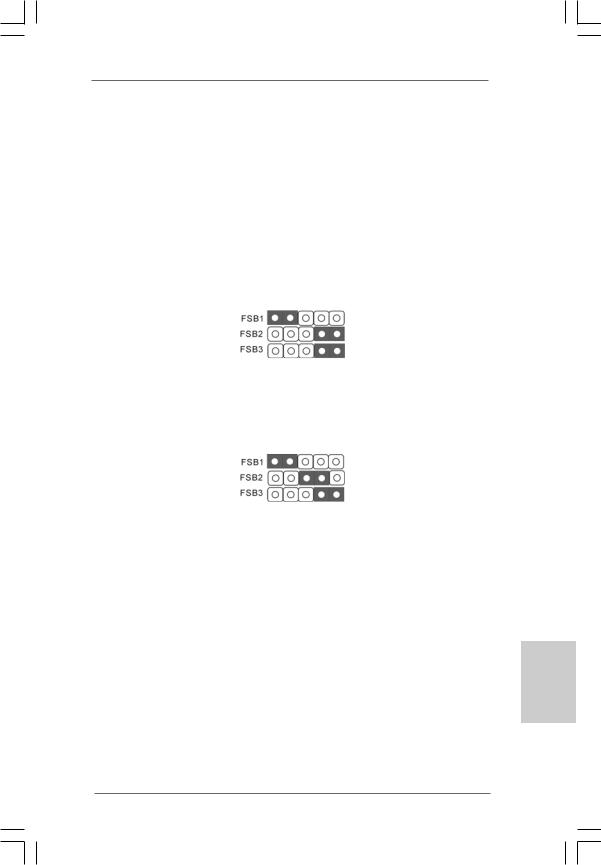
ndard (EuP aktivieren)
uP deaktivieren)
efault-Einstellung
Übertaktungseinstellungen („Overclocking“):
Wenn Sie eine FSB800oder FSB1066-CPU einsetzen und eine Übertaktung auf FSB1333 (per BIOS-Einstellung) versuchen, kann das Problem auftreten, dass die DRAM-Frequenz sehr stark übertaktet wird. Bitte nutzen Sie Steckbrückeneinstellungen zum Fixieren der NB auf eine höhere Frequenz, damit das DRAM mit einer niedrigeren Frequenz arbeiten kann.
Wenn Sie die CPU zur Nutzung von FSB1066 mit diesem Motherboard übertakten möchten, müssen Sie Steckbrückeneinstellungen ändern. Bitte überbrücken Sie die Pins 4 und 5 der Steckbrücke FSB2 und die Pins 4 und 5 der Steckbrücke FSB3.
Andernfalls arbeitet die CPU eventuell nicht richtig mit Ihrem Motherboard. Bitte schauen Sie sich die nachstehenden Steckbrückeneinstellungen an.
Wenn Sie die CPU zur Nutzung von FSB1333 mit diesem Motherboard übertakten möchten, müssen Sie Steckbrückeneinstellungen ändern. Bitte überbrücken Sie die Pins 3 und 4 der Steckbrücke FSB2 und die Pins 4 und 5 der Steckbrücke FSB3.
Andernfalls arbeitet die CPU eventuell nicht richtig mit Ihrem Motherboard. Bitte schauen Sie sich die nachstehenden Steckbrückeneinstellungen an.
Deutsch
2 9
ASRock G41M-GS Motherboard
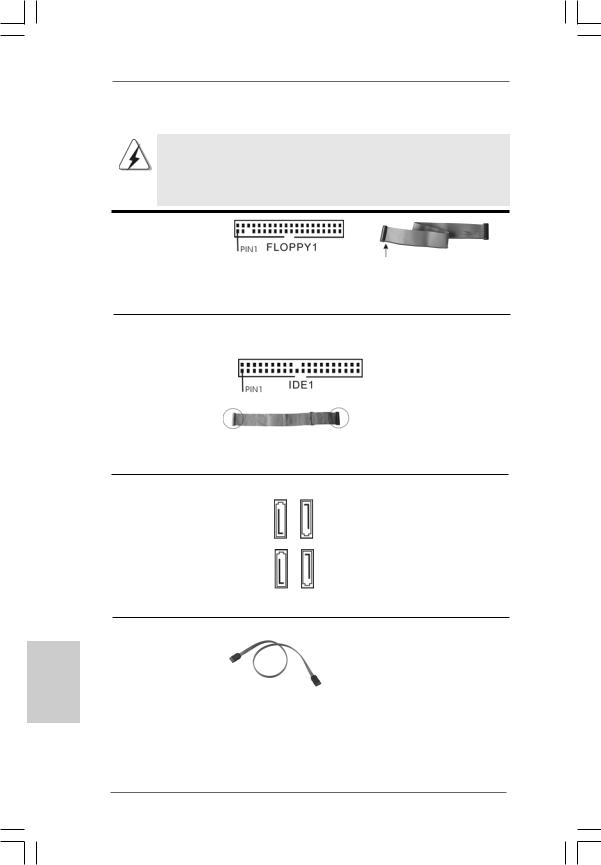
Deutsch
1.4 Integrierte Header und Anschlüsse
Integrierte Header und Anschlüsse sind KEINE Jumper. Setzen Sie KEINE Jumperkappen auf diese Header und Anschlüsse. Wenn Sie Jumperkappen auf Header und Anschlüsse setzen, wird das Motherboard unreparierbar beschädigt!
Anschluss für das Floppy-Laufwerk
(33-Pin FLOPPY1)
die rotgestreifte Seite auf Stift 1
(siehe S.2 - No. 20)
Hinweis: Achten Sie darauf, dass die rotgestreifte Seite des Kabel mit der Stift 1- Seite des Anschlusses verbunden wird.
Primärer IDE-Anschluss (Blauer)
(39-pin IDE1, siehe S.2 - No. 7)
Blauer Anschluss |
Schwarzer Anschluss |
zum Motherboard |
zur Festplatte |
|
80-adriges ATA 66/100 Kabel |
Hinweis: Details entnehmen Sie bitte den Anweisungen Ihres IDE-Gerätehändlers.
Seriell-ATAII-Anschlüsse
(SATAII_1: siehe S.2, Punkt 13) (SATAII_2: siehe S.2, Punkt 12) (SATAII_3: siehe S.2, Punkt 10) (SATAII_4: siehe S.2, Punkt 11)
SATAII 3 |
SATAII 4 |
SATAII 1 |
SATAII 2 |
Diese vier Serial ATA (SATA II) -Anschlüsse unterstützen interne SATAoder SATA II-Festplatten. Die aktuelle SATAII-Schnittstelle ermöglicht eine Datenübertragungsrate bis 3,0 Gb/s.
Serial ATA- (SATA-) |
Sie können beide Enden des |
Datenkabel |
SATA-Datenkabels entweder |
(Option) |
mit der SATA / SATAII- |
|
Festplatte oder |
|
dem SATAII-Anschluss am |
|
Mainboard verbinden. |
3 0
ASRock G41M-GS Motherboard
